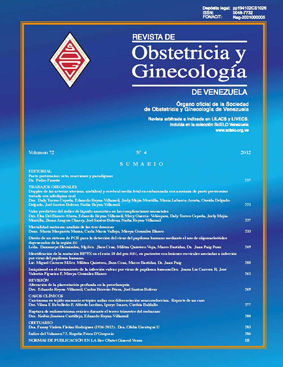Control del puerperio en mujeres peruanas de zona urbana y rural: análisis secundario de una encuesta nacional
Keywords:
Periodo Posparto, Atención Posnatal, Personal de Salud, Área Urbana, Área Rural, Postpartum Period, Postnatal Care, Health Personnel, Urban Area, Rural AreaAbstract
To compare the characteristics of postpartum control from Peruvian women in urban and rural areas. Methods: A cross-sectional study, carried out from the 2020 Demographic and Family Health Survey, analyzed 9017 records of women of reproductive age. Weighted and unweighted counts were estimated; and the chi square test was used at a 95% confidence level. Results: 97.1% of the women had postpartum control. In urban and rural areas, the prevalence of this service was 98.7% and 91.1%, respectively. 78.9% of women in urban areas had their first check-up within 4 hours after giving birth, 45.2% were seen by a doctor, and 58.2% received care in health facilities of the Ministry of Health. In rural areas, 35.1% received care from a professional Obstetrician, 12.3% had control between the first 4 and 23 hours of delivery, and 8.2% received this care at home or in the house of the midwife. Conclusions: In rural areas, compared to urban areas, postpartum control is less prevalent. The provision of this service in the shortest possible time, by health professionals and in health facilities, is significantly higher in urban areas.
Downloads
References
DeCherney AH, Nathan L, Laufer N, Roman AS. Diagnóstico y tratamiento ginecoobstétricos 11ª Edición. México DF: Editorial McGraw Hill; 2014.
Cunningham FG, Leveno KJ, Bloom SL, Spong CY, Dashe JS, Hoffman BL, Casey BM, Sheffield JS. Williams Obstetricia. 24ª Edición. Buenos Aires: Editorial McGraw Hill; 2015.
Paladine HL, Blenning CE, Strangas Y. Postpartum Care: An Approach to the Fourth Trimester. Am Fam Physician [Internet]. 2019 [consultado 9 de diciembre de 2021]; 100(8): 485-491. Disponible en: https://www.aafp.org/afp/2019/1015/p485.html
Martínez-Galiano JM, Hernández-Martínez A, Rodríguez-Almagro J, Delgado-Rodríguez M, Rubio-Alvarez A, Gómez-Salgado J. Women’s Quality of Life at 6 Weeks Postpartum: Influence of the Discomfort Present in the Puerperium. Int J Environ Res Public Health. 2019; 16(2):253. doi: 10.3390/ijerph16020253.
Burneo G, Contento B, González VR. Atención de enfermería durante el puerperio en un hospital de Machala, Ecuador. Enferm Inv [Internet]. 2018 [consultado 13 de diciembre de 2021]; 3(1):21-25. Disponible en: https://revistas.uta.edu.ec/erevista/index.php/enfi/article/view/410
Ministerio de Salud de Perú [Internet]. Norma Técnica de Salud para la Atención Integral de Salud Materna Lima: MINSA; 2020 [consultado 25 de diciembre de 2021]. Disponible en: http://bvs.minsa.gob.pe/local/MINSA/5013.pdf
Schrey-Petersen S, Tauscher A, Dathan-Stumpf A, Stepan H. Diseases and complications of the puerperium. Dtsch Arztebl Int. 2021; 118:436–446. doi: 10.3238/arztebl.m2021.0168.
VanderKruik R, Barreix M, Chou D, Allen T, Say L, Cohen LS; Maternal Morbidity Working Group. The global prevalence of postpartum psychosis: a systematic review. BMC Psychiatry. 2017; 17(1):272. doi: 10.1186/s12888-017-1427-7.
Langlois ÉV, Miszkurka M, Zunzunegui MV, Ghaffar A, Ziegler D, Karp I. Inequities in postnatal care in low- and middle-income countries: a systematic review and meta-analysis. Bull World Health Organ. 2015; 93(4):259-270G. doi: 10.2471/BLT.14.140996.
Probandari A, Arcita A, Kothijah K, Pamungkasari EP. Barriers to utilization of postnatal care at village level in Klaten district, central Java Province, Indonesia. BMC Health Serv Res. 2017; 17(1):541. doi: 10.1186/s12913-017-2490-y.
Martín R. Importancia de los cuidados continuados de enfermería en el puerperio [Trabajo de Fin de Grado en Internet]. Madrid: Universidad Autónoma de Madrid; 2015. [consultado octubre 2021]. Disponible en: https://repositorio.uam.es/bitstream/handle/10486/676327/martin_blazquez_raqueltfg.pdf?sequence=1
Montenegro E, Arango-Ochante PM. Complicaciones obstétricas durante puerperio mediato, en relación a la nueva clasificación de embarazo a término de la ACOG, en el Hospital de Vitarte. 2018. Rev Peru Investig Matern Perinat. 2020; 9(4): 16-22. doi: https://doi.org/10.33421/inmp.2020215
Centro Nacional de Epidemiología, Prevención y Control de Enfermedades [Internet]. Boletín epidemiológico del Perú-volumen 29 - SE 37-2020. 2020 [consultado 11 de octubre de 2021]. Disponible en: https://cdn.www.gob.pe/uploads/document/file/2136793/Bolet%C3%ADn.pdf.
Instituto Nacional de Estadística e Informática [Internet]. Encuesta Demográfica y de Salud Familiar. 2020. [consultado 16 de noviembre de 2021]. Disponible en: https://www.inei.gob.pe/media/MenuRecursivo/publicaciones_digitales/Est/Lib1795/.
Molina A, Morillas R, Iglesias Moya J. Vivencias en el puerperio. ¿Cómo experimentan las madres la etapa tras el parto? Rev Paraninfo Digital [Internet]. 2017 [consultado 2 de enero de 2022]: (27). Disponible en: http://www.index-f.com/para/n27/pdf/042.pdf
Langa N, Bhatta T. The rural-urban divide in Tanzania: Residential context and socioeconomic inequalities in maternal health care utilization. PLoS One. 2020; 15(11):e0241746. doi: 10.1371/journal.pone.0241746.
Elkhoudri N, Baali A, Amor H. Postnatal Care: Levels and determinants in Morocco. Iran J Public Health [Internet]. 2017 [consultado 3 de enero de 2022; 46(2): 242-248. https://www.ncbi.nlm.nih.gov/pmc/articles/PMC5402784/
Dey T, Ononge S, Weeks A, Benova L. Immediate postnatal care following childbirth in Ugandan health facilities: an analysis of Demographic and Health Surveys between 2001 and 2016. BMJ Glob Health. 2021; 6(4):e004230. doi: 10.1136/bmjgh-2020-004230.
Gebrehiwot G, Medhanyie AA, Gidey G, Abrha K. Postnatal care utilization among urban women in northern Ethiopia: cross-sectional survey. BMC Womens Health. 2018; 18(1):78. doi: 10.1186/s12905-018-0557-5.
Wassie GT, Belete MB, Tesfu AA, Bantie SA, Ayenew AA, Endeshaw BA, et al. Association between antenatal care utilization pattern and timely initiation of postnatal care checkup: Analysis of 2016 Ethiopian Demographic and Health Survey. PLoS One. 2021; 16(10):e0258468. doi: 10.1371/journal.pone.0258468.
Mekonnen T, Dune T, Perz J, Ogbo FA. Postnatal Care Service Utilisation in Ethiopia: Reflecting on 20 Years of Demographic and Health Survey Data. Int J Environ Res Public Health. 2020; 18(1):193. doi: 10.3390/ijerph18010193.
Chen L, Qiong W, van Velthoven MH, Yanfeng Z, Shuyi Z, Ye L, et al. Coverage, quality of and barriers to postnatal care in rural Hebei, China: a mixed method study. BMC Pregnancy Childbirth. 2014; 14:31. doi: 10.1186/1471-2393-14-31.
Ndugga P, Namiyonga NK, Sebuwufu D. Determinants of early postnatal care attendance: analysis of the 2016 Uganda demographic and health survey. BMC Pregnancy Childbirth. 2020; 20(1):163. doi: 10.1186/s12884-020-02866-3

